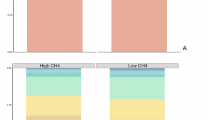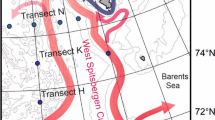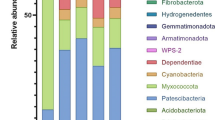Abstract
The quantification and community of bacteria in the gastrointestinal (GI) tract (stomach, jejunum, ileum, cecum, colon and rectum) of red kangaroos (Macropus rufus) were examined by using real-time PCR and paired-end Illumina sequencing. The quantification of bacteria showed that the number of bacteria in jejunum and rectum was significantly lower than that in colon and cecum (P < 0.05). A total of 1,872,590 sequences was remained after quality-filtering and 50,948 OTUs were identified at the 97 % similarity level. The dominant phyla in the GI tract of red kangaroos were identified as Actinobacteria, Bacteroidetes and Firmicutes. At the level of genus, the samples from different parts of GI tract clustered into three groups: stomach, small intestine (jejunum and ileum) and large intestine (cecum and rectum). Prevotella (29.81 %) was the most dominant genus in the stomach and significantly (P < 0.05) higher than that in other parts of GI tract. In the small intestine, Bifidobacterium (33.04, 12.14 %) and Streptococcus (22.90, 19.16 %) were dominant genera. Unclassified Ruminococcaceae was the most dominant family in large intestine and the total relative abundance of unclassified bacteria was above 50 %. In identified genera, Dorea was the most important variable to discriminate large intestine and it was significantly higher in cecum than in stomach, small intestine and colon (P < 0.05). Bifidobacterium (21.89 %) was the only dominant genus in colon. Future work on culture in vitro and genome sequencing of those unidentified bacteria might give us insight into the function of these microorganisms in the GI tract. In addition, the comparison of the bacterial community in the foregut of kangaroos and other herbivores and the rumen might give us insight into the mechanism of fiber degradation and help us exploit approaches to improve the feed efficiency and subsequently, reduce the methane emission from herbivores.






Similar content being viewed by others
References
Bartram AK, Lynch MDJ, Stearns JC, Moreno-Hagelsieb G, Neufeld JD (2011) Generation of multimillion-sequence 16S rRNA gene libraries from complex microbial communities by assembling paired-end illumine reads. Appl Environ Microbiol 77(11):3846–3852
Behrendt L, Larkum AWD, Trampe E, Norman A, Sorensen SJ, Kuhl M (2012) Microbial diversity of biofilm communities in microniches associated with the didemnid ascidian Lissoclinum patella. ISME J 6:1222–1237
Bekele AZ, Koike S, Kobayashi Y (2010) Genetic diversity and diet specificity of ruminal Prevotella revealed by 16S rRNA gene-based analysis. FEMS Microbiol Lett 305:49–57
Caporaso JG, Kuczynski J, Stombaugh J, Bittinger K, Bushman FD, Costello EK, Fierer N, Pena AG, Goodrich JK, Gordon JI, Huttley GA, Kelley ST, Knights D, Koenig JE, Ley RE, Lozupone CA, McDonald D, Muegge BD, Pirrung M, Reeder J, Sevinsky JR, Turnbaugh PJ, Walters WA, Widmann J, Yatsunenko T, Zaneveld J, Knight R (2010) QIIME allows analysis of high-throughput community sequencing data. Nat Methods 7:335–336
De Filippo C, Cavalieri D, Di Paola M, Ramazzotti M, Poullet JB, Massart S, Collini S, Pieraccini G, Lionetti P (2010) Impact of diet in shaping gut microbiota revealed by a comparative study in children from Europe and rural Africa. Proc Natl Acad Sci USA 107:14691–14696
Derrien M, Vaughan EE, Plugge CM, de Vos WM (2004) Akkermansia muciniphila gen. nov., sp. nov., a human intestinal mucin-degrading bacterium. Int J Syst Evol Microbiol 54:1469–1476
Duncan SH, Louis P, Flint HJ (2007) Cultivable bacterial diversity from the human colon. Lett Appl Microbiol 44:343–350
Edwards JE, McEwan NR, Anthony JT, Wallace RJ (2004) 16S rDNA library-based analysis of ruminal bacterial diversity. Antonie Van Leeuwenhoek 86:263–281
Favier CF, Vaughan EE, De Vos WM, Akkermans ADL (2002) Molecular monitoring of succession of bacterial communities inhuman neonates. Appl Environ Microbiol 68:219–226
Fulghum RS, Moore WE (1963) Isolation, enumeration, and characteristics of proteolytic ruminal bacteria. J Bacteriol 85:808–815
Fuller R, Houghton SB, Brooker BE (1981) Attachment of Streptococcus faecium to the duodenal epithelium of the chicken and its importance in colonization of the small intestine. Appl Environ Microbiol 41(6):1433–1441
Gulino L, Ouwerkerk D, Kang AYH, Maguire AJ, Kienzle M, Klieve AV (2013) Shedding light on the microbial community of the macropod foregut using 454-amplicon pyrosequencing. PLoS ONE 8(4):e61463
Hume ID (1984) Principal features of digestion in kangaroos. Proc Natl Acad Sci USA 9:76–81
Klieve AV, Ouwerkerk D, Maguire AJ (2012) Archaea in the foregut of macropod marsupials: PCR and amplicon sequence-based observations. J Appl Microbiol 113(5):1065–1075
Koike S, Yoshitani S, Kobayashi Y, Tanaka K (2003) Phylogenetic analysis of fiber-associated rumen bacterial community and PCR detection of uncultured bacteria. FEMS Microbiol Lett 229:23–30
Kurakawa T, Ogata K, Matsuda K, Tsuji H, Kubota H, Takada T, Kado Y, Asahara T, Takahashi T, Nomoto K (2015) Diversity of intestinal Clostridium coccoides group in the Japanese population, as demonstrated by reverse transcription-quantitative PCR. PLoS ONE 10(5):e0126226
Lemos LN, Fulthorpe RR, Triplett EW, Roesch LFW (2011) Rethinking microbial diversity analysis in the high throughput sequencing era. J Microbiol Methods 86:42–51
Ley RE, Hamady M, Lozupone C, Turnbaugh PJ, Ramey RR, Bircher JS, Schlegel ML, Tucker TA, Schrenzel MD, Knight R, Gordon JI (2008) Evolution of mammals and their gut microbes. Science 320:1647–1651
Madsen J, Bertelsen MF (2012) Methane production by red-necked wallabies (Macropus rufogriseus). J Anim Sci 90(4):1364–1370
Martinez I, Kim J, Duffy PR, Schlegel VL, Walter J (2010) Resistant starches types 2 and 4 have diferential effects on the composition of the fecal microbiota in human subjects. PLoS ONE 5(11):e15046
Milani C, Lugli GA, Duranti S, Turroni F, Bottacini F, Mangifesta M, Sanchez B, Viappiani A, Mancabelli L, Taminiau B, Delcenserie V, Barrangou R, Margolles A, van Sinderen D, Ventura M (2014) Genomic encyclopedia of type strains of the genus Bifidobacterium. Appl Environ Microbiol 80(20):6290–6302
Milani C, Andrea Lugli G, Duranti S, Turroni F, Mancabelli L, Ferrario C, Mangifesta M, Hevia A, Viappiani A, Scholz M, Arioli S, Sanchez B, Lane J, Ward DV, Hickey R, Mora D, Segata N, Margolles A, van Sinderen D, Ventura M (2015a) Bifidobacteria exhibit social behavior through carbohydrate resource sharing in the gut. Sci Rep 5:15782
Milani C, Turroni F, Duranti S, Lugli GA, Mancabelli L, Ferrario C, van Sinderen D, Ventura M (2015b) Genomics of the genus Bifidobacterium reveals species-specific adaptation to the 2 glycan-rich gut environment. Appl Environ Microbiol. doi:10.1128/AEM.03500-15
Miyazaki K, Martin JC, Marinsek-Logar R, Flint HJ (1997) Degradation and utilization of xylans by the rumen anaerobe Prevotella bryantii (formerly P. ruminocola subsp. brevis) B14. Anaerobe 3:373–381
Muegge BD, Kuczynski J, Knights D, Clemente JC, Gonzalez A, Fontana L, Henrissat B, Knight R, Gordon JI (2011) Diet drives convergence in gut microbiome functions across mammalian phylogeny and within humans. Science 332:970–974
Pope PB, Denman SE, Jones M, Tringe SG, Barry K, Malfatti SA, McHardy AC, Cheng JF, Hugenholtz P, McSweeney CS, Morrison M (2010) Adaptation to herbivory by the Tammar wallaby includes bacterial and glycoside hydrolase profiles different from other herbivores. Proc Natl Acad Sci USA 107:14793–14798
Roger LC, Costabile A, Holland DT, Hoyles L, McCartney AL (2010) Examination of faecal Bifidobacterium populations in breast- and formula-fed infants during the first 18 months of life. Microbiology 156:3329–3341
Sakamoto M, Ohkuma M (2012) Reclassification of Xylanibacter oryzae as Prevotella oryzae comb. nov., with an emended description of the genus Prevotella. Int J Syst Evol Microbiol 62:2637–2642
Schell MA, Karmirantzou M, Snel B, Vilanova D, Berger B, Pessi G, Zwahlen MC, Desiere F, Bork P, Delley M, Pridmore RD, Arigoni F (2002) The genome sequence of Bifidobacterium longum reflects its adaptation to the human gastrointestinal tract. Proc Natl Acad Sci USA 99(22):14422–14427
Scupham AJ, Patton TG, Bent E, Bayles DO (2008) Comparison of the cecal microbiota of domestic and wild turkeys. Microb Ecol 56:322–331
Shah HN, Collins DM (1990) Prevotella, a neo genus to include Bacteroides melaninogenicus and related species formerly classified in genus Bacteroides. Int J Syst Bacteriol 40(2):205–208
Stevenson DM, Weimer PJ (2007) Dominance of Prevotella and low abundance of classical ruminal bacterial species in the bovine rumen revealed by quantification real-time PCR. Appl Microbiol Biotechnol 75:165–174
Taras D, Simmering R, Collins MD, Lawson PA, Blaut M (2002) Reclassification of Eubacterium formicigenerans as Dorea formicigenerans gen. nov., comb. nov., and description of Dorea longicatena sp. nov., isolated from human faeces. Int J Syst Evol Microbiol 52:423–428
Tyndale-Biscoe CH (2005) Life of marsupials. CSIRO, Collingwood
Ueki A, Akasaka H, Suzuki D, Hattori S, Ueki K (2006) Xylanibacter oryzae gen. nov., sp. nov., a novel strictly anaerobic, Gram-negative, xylanolytic bacterium isolated from rice-plant residue in flooded rice-field soil in Japan. Int J Syst Evol Microbiol 56:2215–2221
Ueki A, Akasaka H, Satoh A, Suzuki D, Ueki K (2007) Prevotella paludivivens sp. nov., a novel strictly anaerobic, Gram-negative, hemicelluloses-decomposing bacterium isolated from plant residue and rice roots in irrigated rice-field soil. Int J Syst Evol Microbiol 57:1803–1809
Van Passel MWJ, Kant R, Zoetendal EG, Plugge CM, Derrien M, Malfatti SA, Chain PSG, Woyke T, Palva A, de Vos WM, Smidt H (2011) The genome of Akkermansia muciniphila, a dedicated intestinal mucin degrader, and its use in exploring intestinal metagenomes. PLoS ONE 6(3):e16876
Vendl C, Clauss M, Stewart M, Leggett K, Hummel J, Kreuzer M, Munn A (2015) Decreasing methane yield with increasing food intake keeps daily methane emissions constant in two foregut fermenting marsupials, the western grey kangaroo and red kangaroo. J Exp Biol 218(Pt 21):3425–3434
Walker AW, Ince J, Duncan SH, Webster LM, Holtrop G, Ze X, Brown D, Stares MD, Scott P, Bergerat A, Louis P, McIntosh F, Johnstone AM, Lobley GE, Parkhill J, Flint HJ (2011) Dominant and diet-responsive groups of bacteria within the human colonic microbiota. ISME J 5(2):220–230
Wallace RJ, McKain N, Broderick GA, Rode LM, Walker ND, Newbold CJ, Kopecny J (1997) Peptidases of the rumen bacterium, Prevotella ruminocola. Anaerobe 3:35–42
Wright ADG, Klieve AV (2011) Does the complexity of the rumen microbial ecology preclude methane mitigation? Anim Feed Sci Technol 166(167):248–253
Wu GD, Chen J, Hoffmann C, Bittinger K, Chen YY, Keilbaugh SA, Bewtra M, Knights D, Walters WA, Knight R, Sinha R, Gilroy E, Gupta K, Baldassano R, Nessel L, Li H, Bushman FD, Lewis JD (2011) Linking long-term dietary patterns with gut microbial enterotypes. Science 334(6052):105–108
Zened A, Combes S, Cauquil L, Mariette J, Klopp C, Bouchez O, Troegeler-Meynadier A, Enjalbert F (2012) Microbial ecology of the rumen evaluated by 454 GS FLX pyrosequencing is affected by starch and oil supplementation of diets. FEMS Microbiol Ecol 83:504–514
Zoetendal EG, Akkermans AD, De Vos WM (1998) Temperature gradient gel electrophoresis analysis of 16S rRNA from humanfecal samples reveals stable and host-specific communities of active bacteria. Appl Environ Microbiol 64(10):3854–3859
Zoetendal EG, Raes J, van den Bogert B, Arumugam M, Booijink CCGM, Troost FJ, Bork P, Wels M, de Vos WM, Kleerebezem M (2012) The human small intestinal microbiota is driven by rapid uptake and conversion of simple carbohydrates. ISME J 6:1415–1426
Acknowledgments
This work was financially supported by Nanjing Hongshan Forest Zoo, China. The authors thank Dr. Thomas J. Sharpton and his lab members at Oregon State University for their help in the analysis of Illumina data.
Author information
Authors and Affiliations
Corresponding author
Ethics declarations
Conflict of interest
The authors declare that they have no conflict of interest.
Ethical standard
The experimental design and procedures were approved by the Animal Care and Use Committee of Nanjing Agricultural University in compliance with the Regulations for the Administration of Affairs Concerning Experimental Animals (The State Science and Technology Commission of People’s Republic of China, 1988). And our manuscript also complied with the Ethical Rules applicable for World Journal of Microbiology and Biotechnology.
Informed consent
Informed consent was obtained from all individual participants included in the study.
Additional information
Meirong Li and Wei Jin have contributed equally to this article.
Electronic supplementary material
Below is the link to the electronic supplementary material.
Rights and permissions
About this article
Cite this article
Li, M., Jin, W., Li, Y. et al. Spatial dynamics of the bacterial community structure in the gastrointestinal tract of red kangaroo (Macropus rufus). World J Microbiol Biotechnol 32, 98 (2016). https://doi.org/10.1007/s11274-016-2054-z
Received:
Accepted:
Published:
DOI: https://doi.org/10.1007/s11274-016-2054-z




